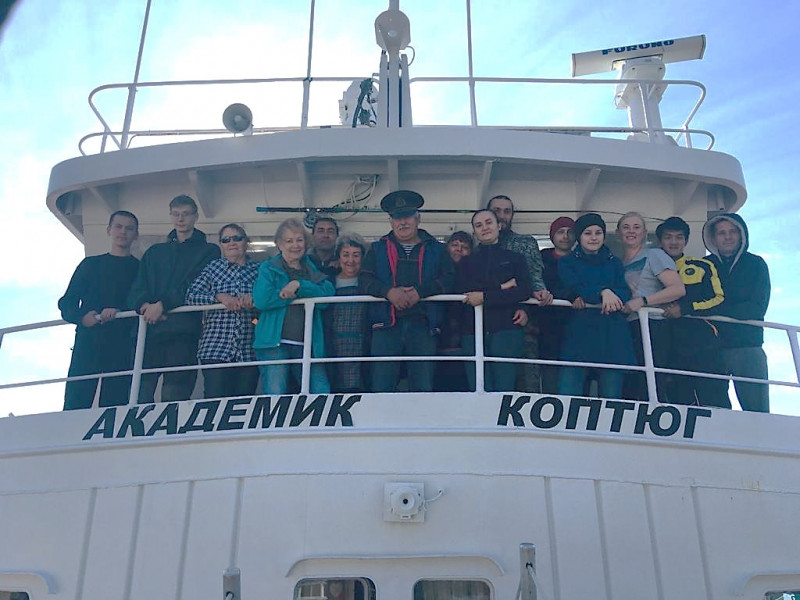Expedition on board the RV “Akademik V.A. Koptyug” from 16 to 26 September, 2022
The expedition was carried out on board the RV “Akademik V.A. Koptyug” from 16 to 26 September 2022 within the program “Study of the impact of seasonal and long-term fluctuations in the level of Baikal on the biotic and abiotic compounds of the littoral zone of the lake and zones of mixing of the river and lake waters” (project № 0279-2021-0016) (directed by A. Fedotov). The fieldworks were conducted in the littoral zone of the settlement of Kultuk, the towns of Slyudyanka, Utulik, Baikalsk, and Vydrino, the settlement of Tankhoi, the town of Babushkin, Posolsky Sor Bay, the town of Gremyachinsk, the settlements of Listvyanka and Bolshiye Koty, Aya Bay, Maloe More Bays, Olkhonskiye Vorota Strait, Chivyrkuisky and Barguzinsky Bays, the Rivers of Medlyanka, Kultuchnaya, Pokhabikha, Slyudyanka, Utulik, Solzan, Bolshaya Osinovka, Snezhnaya, Pereyomnaya, Mysovka, Turka, Kika, Selenga, Barguzin, Buguldeika, and Goloustnaya. The near-mouth areas of the last four Baikal tributaries were investigated in detail. The staff of the Laboratory of Aquatic Microbiology (M.Yu. Suslova, G.V. Podlesnaya), Laboratory of Hydrochemistry and Atmosphere Chemistry (L.P. Golobokova), Laboratory of Hydrology and Hydrophysics (K.M. Kucher), and Laboratory of Aquatic Invertebrate Biology (T.D. Evstigneeva, R.S. Krivorotkin, T.M. Alekseeva) participated in the expedition.
The expedition aimed to study the hydrochemical, microbiological and hydrophysical processes occurring in the littoral zone of the lake and in zones of mixing of river and lake waters under the high-level regime of Lake Baikal.
The planned expeditionary works were fulfilled in full. There were conducted the research at 87 stations. One hundred and fifty water samples were taken for microbiological study and 118 water samples for hydrochemical analysis. Besides, eight coastal sand samples were collected for microbiological analysis and the discharges of the Slyudyanka WWTP (WasteWater Treatment Plant); 79 samples were taken at 23 stations using a dredge for qualitative and quantitative compositional analysis of taxocenoses of garpacticoides and microturbellaria; qualitative samples were taken at 17 stations near rivers for morphoecological studies of garpacticoides.
The samples were collected according to a standard grid of stations from the surface and near-bottom horizons using 5-liter bathometers in the mixing zones of the Selenga, Barguzin, Buguldeika and Goloustnaya Rivers. The water samples were taken for chemical (pH, electroconductivity, oxygen, principle ions, biogenic elements, and organic matter), microbiological analysis and determination of suspended matter. The upper (100 m) layer soundings were conducted at all 50 stations using JFE-Rinko CTD probe with sensors of temperature, electroconductivity, oxygen, turbidity, fluorescence, Ph, Eh, and PAR.
Water quality was assessed at all stations for the main sanitary-microbiological parameters, and 11 of them were found to exceed the standards of SanPiN 1.2.3685-21 "Hygienic standards and requirements to ensure the safety and (or) innocuity of the habitat factors for humans ". They are 4 of 21 studied coastal regions (opposite the settlement of Bolshoye Goloustnoe, in Olkhonskie Vorota Strait (Zagli Bay), Chivyrkuisky Bay (Kurbulik Settlement, Zmeinaya Bay), 6 of 17 rivers (Medlyanka, Pokhabikha, Slyudyanka, Mysovka, Kharauz, and Srednyaya) and 1 of 2 studied hydrotherms of Zmeinaya Bay. Significant exceedances of sanitary and bacteriological indicators were detected in the Rivers Medlyanka, Pokhabikha, and Mysovka. The Medlyanka River recorded exceeding the values of TCB in 1.8 times, enterococci – in 7 times; the Pochabikha River: TCB – in 202 times, E. coli – in 710 times, enterococci – in 1700 times; the Mysovka River: TCB - in 20 times, E. coli – in 83.5 times, enterococci – in 1700 times. The poor water quality is the result of the sewage runoff of the nearby towns.
According to the analysis results, the treated effluent of the Slyudyanka WWTP does not meet the requirements of SanPiN 1.2.3685-21 and recorded an excess of all values: TCB - 3860 times, E. coli- 19300 times, enterococci - 3600 times and coliphages - 205 times, which indicates, most likely, the absence of disinfection stages.
It was found that the eight study areas where the coastal soil samples were taken belonged to 5 degrees of epidemiological danger:
- extremely dangerous – in Zmeinaya Bay;
- dangerous – in Aya Bay;
- moderately dangerous – in the towns of Baikalsk and Slyudyanka;
- tolerable – in the settlements of Bolshiye Koty, Maloe More, and Kurbulik;
- clean – in the settlement of Kultuk.



















